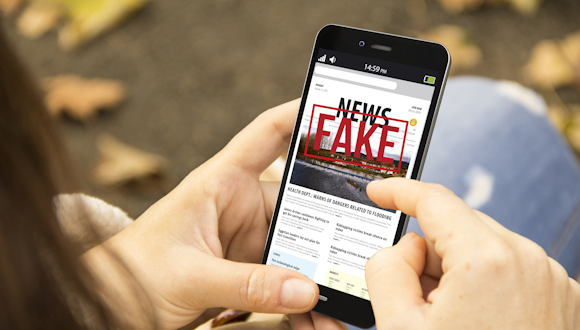Fake news in wartime – Is it possible to detect fake news in our age of advanced technologies? How to deal with them?
We met Dr. Sandrine Boudana, Head of the Department of Communication, who analyzed the fake news phenomenon for us and gave tips on how to conduct ourselves on social and traditional media to fight fake news.
Today, more than ever before, one of the fiercest battles for the support of local and international public opinions is taking place on social networks. While information is so easily accessible (perhaps even too much) and reaches everyone's cell phone, without proper filtering or monitoring, many questions arise regarding our ability to defend ourselves against false news. Dr. Sandrine Boudana, Chair of the Department of Communication, helps us to sort out the mess:
Is it possible to identify in real-time if the news is fake or real?
Three interconnected phenomena or trends have made it more and more complicated to identify fake news. The first consists of the globalization of information that started in the early 1990s, with the emergence of cable and satellite television and its demand for a 24/7 cycle of news: instantaneous reporting on what happens in the world leads to the circulation of many false reports, sometimes by established news organizations manipulated by propagandist sources. The war in Iraq is a good example of this. The second is the increased importance of social media in the production and circulation of information and news. On social media, we are all news users, who assign or self-assign the tasks of creating, editing, and spreading news. Identifying sources and evaluating their credibility has become an endless task. Third, AI, and in particular deepfakes, make it very complicated to detect fabricated images.
Cross-referencing sources and content analysis
The important part of your question is" in real time". Cross-checking sources, and asking for experts' analyses require time. For example, in the recent case of the bombing of the hospital in Gaza, the media rushed to publish Hamas' statement. It took days for images to be shown and for experts' voices to be heard. As journalists and citizens are not able to detect fake news in real-time, they need to be extra careful: insist on the identity of the sources evaluate their credibility, and explain that the report may evolve based on further verification.
What can be done when you come across fake news online?
It depends on the nature of the fake news, its actors, and the context. Often, we want to react by posting the "real news" and responding to the one who spread the fake news. The correction of the fake news seems natural and the right thing to do. But those responding must provide credible sources. Responding must present convincing sources (institutional voices, such as the United Nations or the European Union, or experts) for instance by posting the link to solid references. Even then, responding may open an endless debate, a dialogue of the deaf, which will only give more publicity to the fake news. In the case of the war with Hamas, Israelis who would try to oppose pro-Hamas propaganda might be outnumbered by their opponents. On social media, the mass, rather than the truth-teller, is right. If the fake news can be considered as incitement to hatred or an apology for terrorism, I would encourage you to take a screenshot of the post and report it on website pages that governments have opened so the authors can be identified and prosecuted. Finally, of course, you can report it to the network, although moderators sometimes reach surprising conclusions.
How can the mental damage of news that has already been disseminated and influenced international public opinion be reduced – on a personal level as well as on a political level?
At the individual level, on social media: I know that it's easier said than done, but my main advice would be to avoid reacting with emotional and endless comments so that the fake post does not get more publicity than it already has. Correcting fake news in face-to-face interactions in daily "real" life, seems more efficient, even if we feel that it reaches only a limited number of people. If you give this small number of people concrete facts, numbers, historical backgrounds, and good punchlines, chances are they will re-use them in other social circles.
At the government's level: Officials (the government, the army) must react quickly and as precisely as possible, and be transparent about what they know or do not know. But again, speed and accuracy might be antinomic, especially in wartime. I have two examples in mind. In 2000, a Palestinian boy, Muhammad Al Durrah, was caught in a crossfire between Palestinians and the IDF and was killed. The Israeli government then decided to react quickly by acknowledging the responsibility of the IDF and by expressing regrets for this "mistake". Its quick reaction was notably motivated by a strategic calculation: admission of guilt would close the case and encourage public opinions to move to the next news story. But the opposite happened. This media coverage of this event triggered the Second Intifada. After investigation, the Israeli side claimed that they were not responsible for the killing of the boy, and to this day are fighting to impose their (new) version. But it was too late. The second case is the killing of Shireen Abu Akleh in Gaza in 2022. This time, the Israeli government decided to make, quickly, a statement that would deny responsibility for the Al Jazeera journalist. But then evidence of the opposite accumulated and the government had to acknowledge that a "mistake" was made. In this case, the Israeli side dismissed as fake news a claim whose confirmation or rejection required further investigation. The balance is difficult to find.
Discrediting the source of the news
Another strategy consists of discrediting the source based on past mistakes. We can use fake news that has been recognized as such examples as a deterrent. Even the most credible sources, such as the New York Times have circulated fake news. The textbook case is the 1989 Timisoara massacre affair: Western media have all published fake news about a mass massacre in Romania based on a fake picture of mass graves. The news media have all been influenced by one another into publishing the same fake news. Journalists have also been victims of a confirmation bias: they expected Ceausescu to be the sort of evil dictator who orders mass murders; they were prone to believe that a mass murder happened when they were told so, even if this accusation was only based on a picture.
The last example that I have in mind is the photograph exhibited in a pro-Palestinian demonstration in Egypt: the picture of a Palestinian baby girl in a pink pyjama emerging from the ruins of a building. The photograph was used by some Western media, notably the French Paper of Record Liberation. But it turned out to be a fabricated image: the baby was created by AI tools in February 2023; she has never existed. This should serve as a lesson. Unfortunately, during the Second Intifada, Liberation had already made a similar mistake by putting on its front page the picture of a Palestinian boy with blood running down his face. As it turned out, the boy was an American Jewish student who had just been lynched by a Palestinian crowd. It might be a pious hope but, maybe, if we remind Liberation of its two big fake news it will be a bit more careful and not spread the next one.
Doctor Sandrine Boudana is Chair of the Department of Communication. She specializes in journalism studies, with an emphasis on the news coverage of violence, conflicts, and wars, and on war photography from a comparative cross-national perspective. Her publications focus on issues related to journalistic objectivity, news bias, the ritual role of the news, and the impact of iconic images in media and collective memories.





